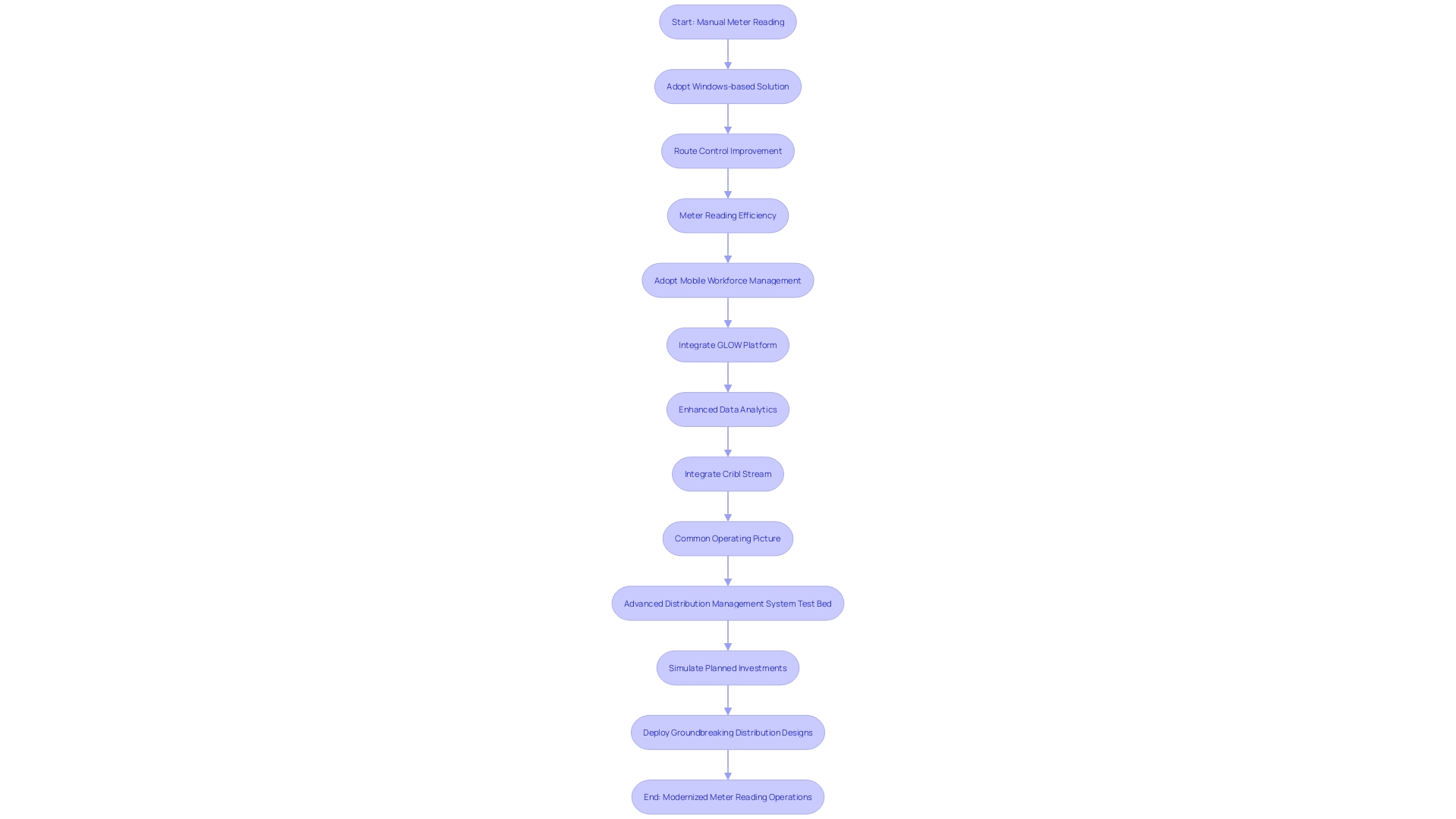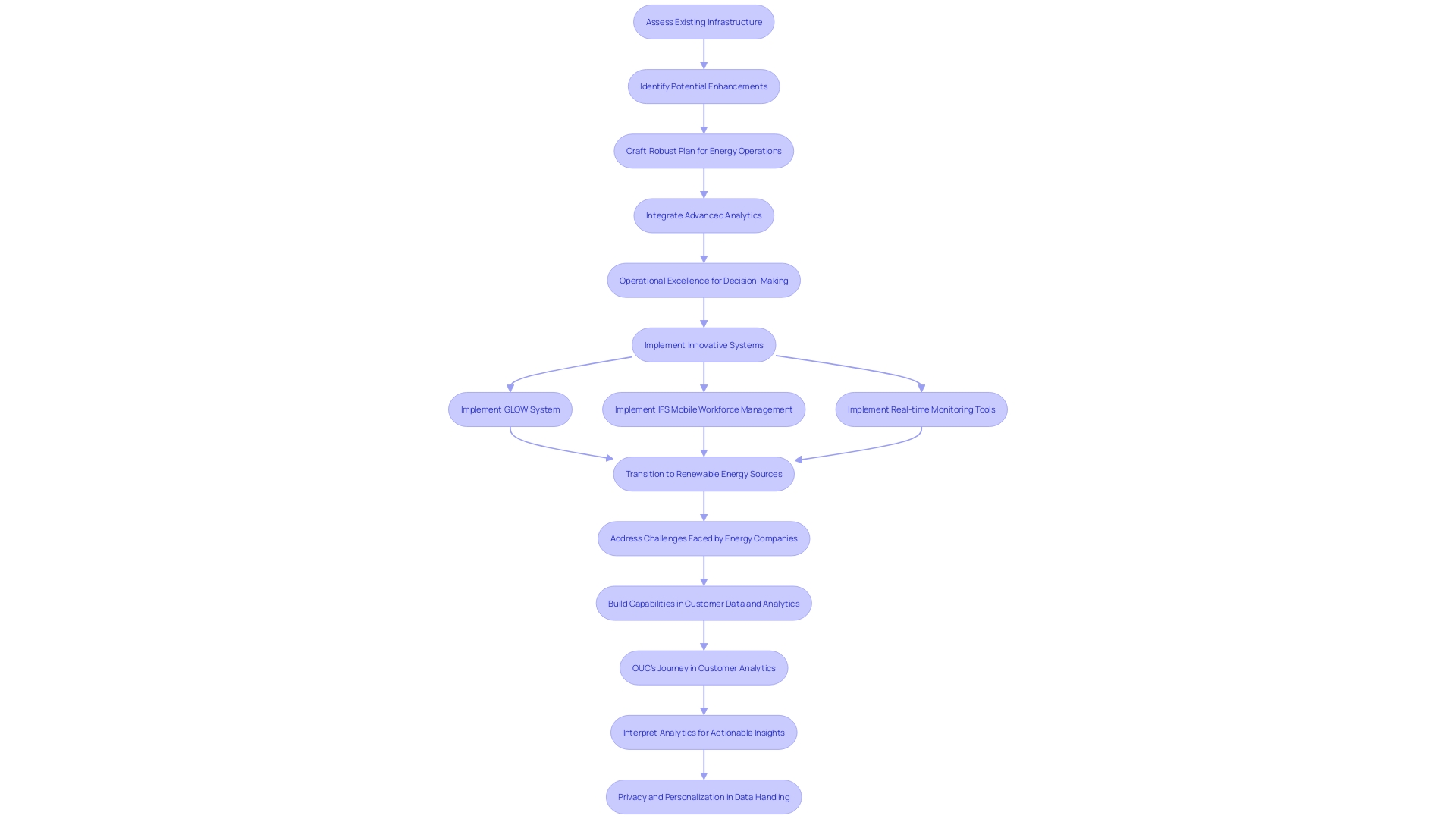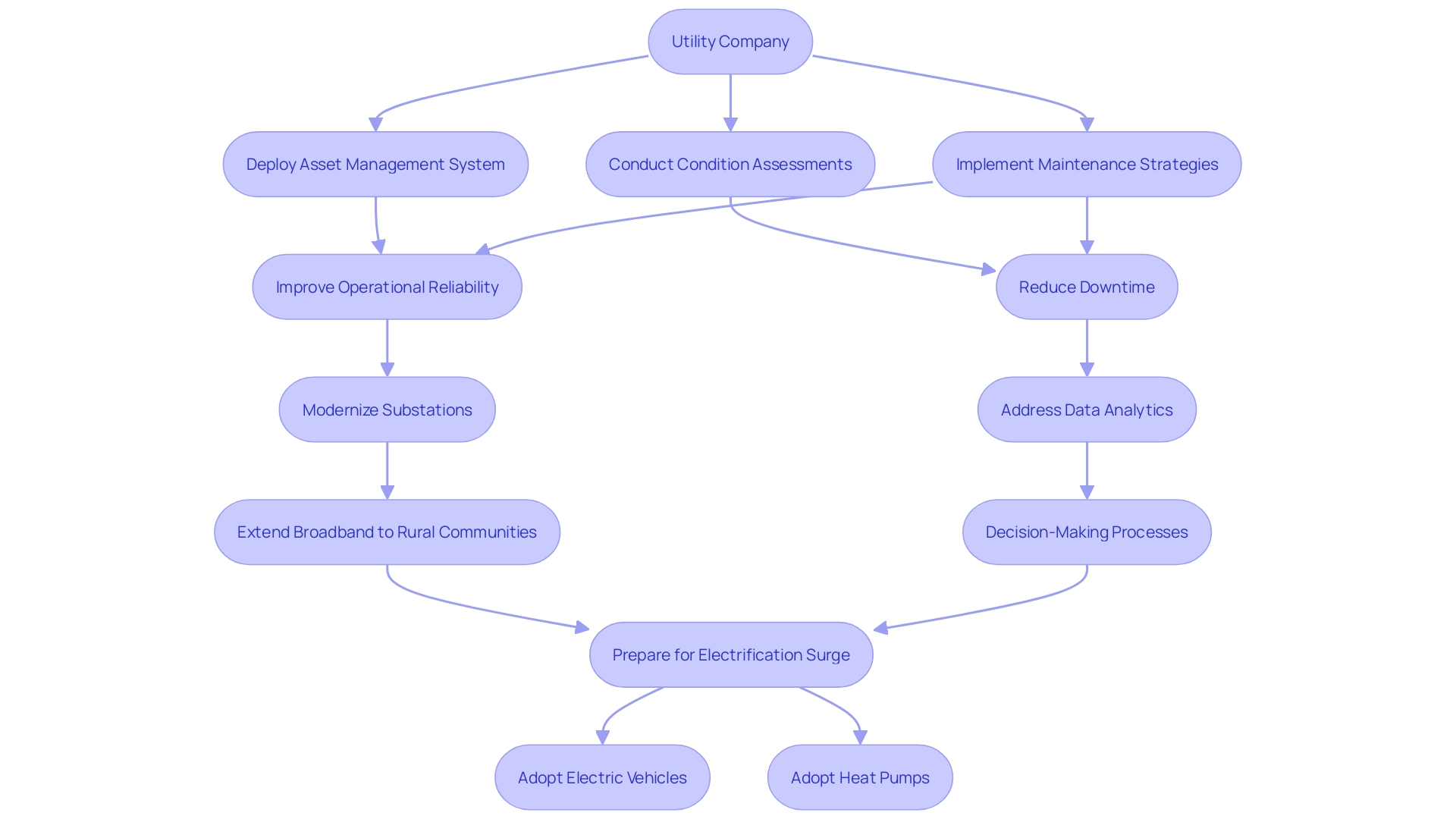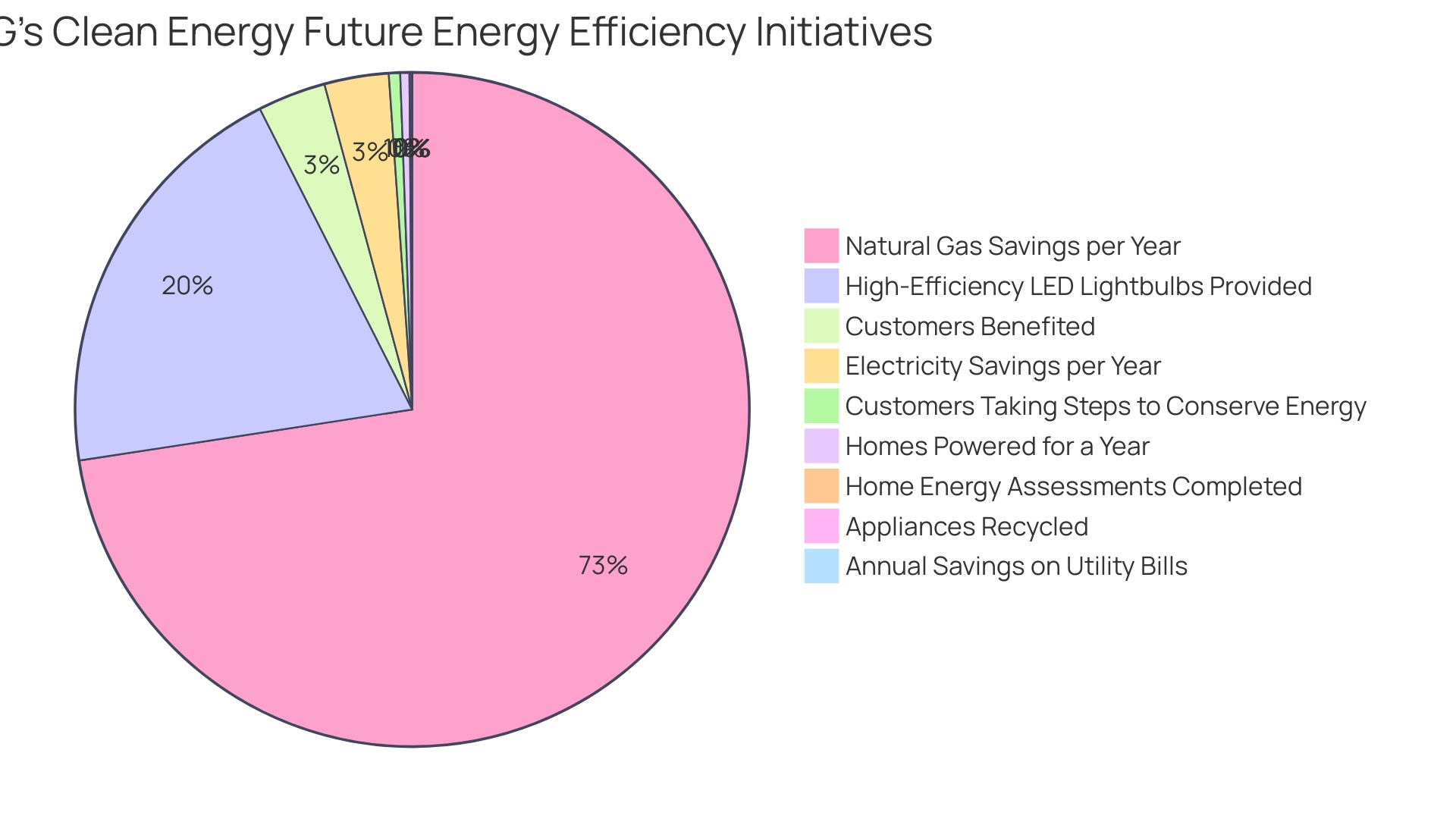Introduction
Electric utility operations face numerous challenges in optimizing energy operations, from aging infrastructure and evolving regulatory landscapes to surging electricity demands and the integration of renewable energy sources. To address these complex hurdles, utility companies are turning to innovative technology solutions that provide reliability and efficiency in energy delivery. One such example is American Electric Power (AEP), which transformed its meter reading operations by adopting advanced mobile workforce management systems, moving away from traditional manual processes.
Utility companies are also leveraging platforms like GLOW and Cribl Stream to streamline operations and make data-driven decisions. The challenges of transmission and distribution systems, such as solar generation and electric vehicle charging stations, require updates and investments. The Advanced Distribution Management System test bed helps utilities simulate investments and design groundbreaking distribution systems.
The energy transition also involves physical challenges, such as low-emissions energy and critical minerals, which further emphasize the need for technological innovation and data accessibility in the electric utility industry.
Key Challenges in Electric Utility Operations
Electric utility operations are navigating a complex landscape as they strive to optimize energy operations amid aging infrastructure, surging electricity demands, evolving regulatory landscapes, and the integration of renewable energy sources. Innovative technology solutions are at the forefront of addressing these multifaceted challenges, providing utility companies with tools to maintain reliability and efficiency in energy delivery.
Consider the transformative journey of American Electric Power (AEP), which overcame the challenge of modernizing meter reading operations by transitioning from manual, paper-based processes to advanced mobile workforce management systems. This evolution began with the adoption of a Windows-based wireless solution for route control and meter reading, marking a significant step away from traditional methods.
Furthermore, utility companies are now leveraging platforms like GLOW and Cribl Stream, which furnish a Common Operating Picture, enabling streamlined operations and data-driven decisions. For instance, GLOW has revolutionized the way utility engineers approach daily grid challenges by automating information gathering, thus expediting grid analysis and minimizing the time and expense associated with it.
In the context of transmission and distribution (T&D) systems, challenges such as the high penetration of solar generation producing bi-directional power flows and the burgeoning number of electric vehicle charging stations are prompting a rethink of the protection system. These challenges necessitate expensive and time-consuming updates to accommodate new energy realities.
Amidst these operational hurdles, the Advanced Distribution Management System test bed stands out as a crucial tool, allowing utilities to simulate planned investments and product deployments, paving the way for groundbreaking distribution system designs.
The path forward also includes overcoming the physical challenges of the energy transition, as identified across seven domains requiring transformation. These efforts are still in the preliminary stages, but the pursuit of low-emissions energy to power mobility, industry, and buildings is vital. Furthermore, critical minerals, new fuels, and carbon and energy reduction play enabling roles in this transition.
Huawei, a global ICT infrastructure and smart device provider, is deeply involved in supporting the electric power industry with intelligent solutions, helping power companies navigate towards secure, efficient, green, and sustainable development. With such multidimensional challenges at hand, the electric utility industry's reliance on technological innovation and data accessibility has never been more critical to its agility and resilience.

Strategic Approach to Optimizing Electric Utility Operations
Optimizing electric utility operations mandates a comprehensive and strategic approach that integrates assessment of existing infrastructure, identification of potential enhancements, and the crafting of a robust plan aimed at elevating the performance of energy operations. Embracing advanced analytics and operational excellence is crucial for informed decision-making that can lead to significant improvements in efficiency and reliability.
One illustrative example comes from the innovative GLOW system, which automates the collection of critical information, thereby streamlining the grid analysis process for utility engineers. This sharp contrast to traditional methods, where engineers would have to consult with numerous team members to understand the impact of new energy resources on the grid's reliability and sustainability, signifies a major leap towards operational efficiency.
Similarly, the Orlando Utilities Commission (OUC) realized that harnessing customer analytics required the integration of vast data from multiple sources. Luz Aviles, Vice President of Customer Experience and Sales, highlighted the vital role of interpreting analytics to drive actionable insights, underscoring the need for dedicated personnel to consistently engage with data analytics.
American Electric Power (AEP) serves as a case study in transitioning from conventional, manual meter reading methods to a technology-driven approach with IFS Mobile Workforce Management (MWM). This transition, which began with the adoption of a Windows-based wireless solution for meter reading, demonstrates the potential for innovation in modernizing utility operations.
Furthermore, the importance of real-time monitoring systems for enhancing grid performance cannot be overstated. These systems facilitate proactive grid management, ensuring optimal asset utilization and preventing overloading, as echoed by the Federal Energy Regulatory Commission (FERC) Order 881, which mandates transparency in transmission line usage. Dynamic line rating (DLR) tools exemplify the kind of technological solutions that allow grid management specialists to make informed decisions based on real-time data.
The agility and resilience of energy and utility companies are being tested as they navigate the transition to renewable energy sources and adapt to changes in the political and regulatory landscape. The absence of readily accessible data formats poses a significant challenge to maintaining operational efficiency in the face of economic pressures, talent scarcity, and supply chain issues.
OUC's journey in customer data and analytics reveals that building capabilities in this area can lead to significant benefits. With a focus on customer analytics, OUC has seen an increase in customer satisfaction and has developed a dedicated analytics workforce that continues to deliver value through targeted initiatives, such as water usage monitoring programs.

Case Study: Successful Optimization Initiatives
A leading electric utility company recently embarked on a mission to enhance the reliability and efficiency of their energy operations amidst challenges of an aging infrastructure and surging demand. By deploying a state-of-the-art asset management system, the utility was able to conduct thorough condition assessments, ensuring that maintenance strategies were both effective and economical. The outcome of these strategic efforts was a significant uptick in operational reliability and a notable reduction in instances of downtime.
The utility's journey echoes the sentiments of the International Energy Agency (IEA), which emphasized the urgency of upgrading or replacing almost the entire global power grid infrastructure by 2040 to sustain a reliable electricity supply and reach climate goals. The utility tackled the daunting task of modernizing its vast number of substations, which are critical nodes in the power grid, often located in remote areas and vulnerable to various threats.
This case is reminiscent of the issues faced by Orlando Utilities Commission (OUC), which grappled with the complex task of amalgamating extensive customer data from diverse sources for actionable analytics. As Luz Aviles, Vice President of Customer Experience and Sales at OUC, pointed out, the critical step is not just collecting data but interpreting it to inform decision-making processes.
Similarly, utilities like Mecklenburg Electric Cooperative (MEC) are addressing the digital divide in rural communities by extending their mission beyond electricity to provide crucial broadband infrastructure. This move parallels their historic role in electrifying rural America under the Rural Electrification Act of 1936, showcasing the evolving scope of utility companies in contemporary society.
Through these examples, we see a pattern of utilities not only focusing on immediate operational improvements but also preparing for the electrification surge anticipated with the adoption of electric vehicles, heat pumps, and other technologies. By aligning grid modernization with emission-reduction efforts, utilities stand to enhance customer service for the 21st century, provided that the increased load can be managed effectively.

Improving Grid Reliability and Implementing Smart Grid Technologies
Smart grid technologies are revolutionizing the way electric utilities manage grid reliability, with advanced systems enhancing resilience and minimizing outages. Advanced monitoring systems give utility engineers a comprehensive view of the electricity distribution system, equipping them with the insights needed to predict and respond to potential issues. The GLOW modeling platform embodies this transformation by streamlining the acquisition of critical data, thus accelerating and simplifying grid analysis processes. It represents a significant leap from traditional methods, which typically require extensive manual coordination across teams and stakeholders.
Furthermore, utilities are adopting platforms like Cribl Stream that foster a Common Operating Picture, enabling a cohesive approach to decision-making and operations. This shifts the paradigm from isolated IT efforts to a collaborative environment where data is readily available for operational decisions, including restoration activities—particularly crucial during extreme weather events affecting service territories. Jonah Steinbuck from the California Energy Commission highlights Glow's impact, emphasizing its role in fostering creative solutions to grid management challenges.
With the integration of local renewable energy sources, such as solar panels and wind turbines, alongside backup generators and energy batteries, microgrids emerge as a resilient solution to local outages. These smaller grids can keep the power flowing independently, even when the main grid is compromised. This capability is increasingly pertinent as the electricity sector grapples with climate change and seeks to bolster grid resilience against natural disasters.
Statistical projections suggest a significant rise in onsite power generation, with rooftop photovoltaic systems and combined-heat-and-power installations expected to generate over 7% of total electricity by 2050. The increasing adoption of electric vehicles, though currently a small fraction of total electricity demand, also holds the potential to shape future power requirements. All these developments underscore the need for utilities to adapt to a rapidly evolving energy landscape, maintaining reliability amidst the complexities of grid transformation.
Navigating Regulatory Challenges
Electric utility companies are at the forefront of an evolving energy landscape, where balancing regulatory compliance with operational efficiency is paramount. Companies like OUC (Orlando Utilities Commission) have learned that effective management of customer analytics requires not only collecting large volumes of data but also dedicated resources to interpret and act on that information. Luz Aviles, Vice President of Customer Experience and Sales at OUC, emphasizes the importance of understanding data to make informed decisions. Similarly, the introduction of advanced tools like GLOW is revolutionizing the day-to-day workflow of utility engineers, who can now access critical grid information automatically, enhancing grid reliability and performance. Furthermore, utilities are increasingly aware of the reputational risks associated with environmental and safety concerns, as seen in California where the public and media scrutiny of utility companies is intense, especially in light of wildfire risks and associated economic trade-offs. These case studies illustrate the multifaceted challenges utilities face and the innovative strategies deployed to address them.
In recent news, Entergy Corporation has been recognized for its century-long commitment to sustainability and community engagement, demonstrating the growing importance of corporate social responsibility in the utility sector. Additionally, significant milestones like the removal of hydroelectric dams on the Klamath River highlight a broader industry shift towards environmental restoration and aligning operations with the needs of local ecosystems and communities. These developments are part of a larger narrative of transformation within the energy sector, where the integration of sustainable practices and community-centric initiatives are becoming increasingly central to utility operations.
Leveraging Advanced Analytics and Operational Excellence
Harnessing the power of advanced analytics and operational excellence is transforming the landscape of utility management. By integrating sophisticated data analytics, electric utility companies are unlocking new opportunities to enhance grid reliability, efficiency, and customer satisfaction. Through the strategic use of analytics platforms such as GLOW, utility engineers are able to address hundreds of energy requests with precision, avoiding the previously time-consuming task of manual grid analysis. This automation not only streamlines operations but also reduces costs associated with grid management.
Utility companies like OUC have embraced the challenge of merging vast amounts of data from diverse sources to enable actionable insights. As Luz Aviles, Vice President of Customer Experience and Sales at OUC points out, the real value lies in the consistent interpretation of meter data to drive meaningful decisions. This shift towards data-centric strategies has facilitated a more responsive and customer-oriented approach to utility management.
Moreover, the implementation of platforms such as Cribl Stream has revolutionized how utility companies manage their operations. By providing a common operating picture, it empowers teams across the organization to access vital data, make informed decisions, and rapidly respond to service disruptions, particularly during extreme weather conditions.
The integration of real-time monitoring systems has also been a game-changer for grid performance. By allowing for dynamic grid management, these systems enable utilities to fully utilize grid capacity while maintaining safety and reliability. The importance of such proactive asset management is echoed by regulatory bodies like the Federal Energy Regulatory Commission (FERC) with mandates such as Order 881, promoting transparency in asset utilization.
The advances in digital twin technology further exemplify the industry's leap towards modernization. Simulation software now plays a critical role in assessing the grid's capacity to support new energy resources, and in evaluating the mechanical integrity of aging infrastructure. These digital tools serve as a testament to how utility companies are prioritizing resilience and efficiency to meet today's energy demands and regulatory requirements.
Enhancing Customer Experience through Digital Solutions
Within the electric utility sector, the Orlando Utilities Commission (OUC) has faced significant challenges in harnessing customer analytics. The integration of extensive data from diverse sources required considerable effort and resources. Once consolidated, the utility recognized the need for dedicated personnel to consistently analyze this data to extract actionable insights. Luz Aviles, Vice President of Customer Experience and Sales at OUC, emphasized the importance of interpreting the analytics: "You need people to pay attention to the data the meters are providing and what it’s telling you... What is the data telling you and what are you going to do with it?" This realization has been pivotal in driving customer satisfaction improvements.
American Electric Power (AEP) showcases a 15-year journey of technological adoption, transitioning from traditional, paper-based meter reading to a digital, efficient system through IFS Mobile Workforce Management (MWM). The initial step taken at the Appalachian Power unit in West Virginia was only the first stride towards modernizing operations across their 11-state footprint.
TotalEnergies is another example, with its Digital Factory (TDF) working to bolster the company's digital transformation. Since 2020, TDF has developed over 80 digital solutions, implemented in more than 215 projects across 25 countries. APIs have played a central role in updating TotalEnergies' older information systems, demonstrating a commitment to affordability, sustainability, and reliability of energy.
The integration of advanced analytics in utilities serves dual purposes: enhancing customer relations by identifying high consumption patterns and potential issues, and improving operational response times. The value of these analytics is ultimately realized through improved service to customers, as seen in OUC's ongoing water monitoring and outreach programs.
Global ICT provider Huawei has also made strides in supporting the electric power industry by combining industry best practices with digital platforms, offering intelligent solutions to approximately 200 power companies. Schneider Electric's vision of bringing energy to those without access, while halving the carbon footprint within the next two decades, reflects a strong commitment to sustainability and efficiency.
These case studies illustrate the profound impact digital solutions have on utility companies, enabling them to navigate the complex landscape of customer experience enhancement, process streamlining, and energy consumption efficiency.
Implementing Energy Optimization Models and Cost Savings Strategies
Electric utility companies are increasingly harnessing advanced technologies and innovative strategies to enhance energy optimization and realize cost savings. By examining a series of case studies, we see how these companies have effectively integrated energy optimization models, incorporated renewable energy sources, and embraced cost-saving measures to achieve notable reductions in energy consumption and operational expenses.
One transformative innovation is GLOW, a tool that streamlines the grid analysis process for utility engineers. GLOW automates the gathering of essential information, thus diminishing the time and resources traditionally required for grid analysis. This advancement enriches the understanding of electricity distribution systems and fosters a broader range of problem-solving perspectives among utility planners, regulators, and researchers.
The Orlando Utilities Commission (OUC) has tackled the challenge of customer analytics, which demands the synthesis of vast data sets from numerous sources. OUC's Vice President of Customer Experience and Sales, Luz Aviles, emphasizes the importance of interpreting the data to inform actionable strategies. The integration of analytics has been pivotal in facilitating informed decisions and enhancing customer experiences.
In the realm of operational efficiency, the use of platforms like Cribl Stream has revolutionized data accessibility, leading to more cohesive and informed decision-making processes. This utility company now leverages Cribl Stream not merely as a tool but as a growth-enabling platform, particularly for timely restoration activities during adverse weather events, thereby optimizing service delivery to customers.
Recent reports, such as PSE&G's on its Clean Energy Future Energy Efficiency initiatives, illustrate the tangible benefits of energy conservation efforts. The program has reached approximately 1.8 million customers, with 300,000 actively conserving energy. The resulting annual savings are substantial, equating to nearly 1.7 million megawatt hours of electricity—enough to power over 240,000 homes for a year.
Experts in the field, as highlighted in the Four Pillars of the Clean Energy Transition by NERC, are calling attention to the pressing threats to electricity reliability. The decline in reserve margins and the urgency to expedite interconnection queues are among the critical concerns. Additionally, the increasing electrification of the economy places further demand on peak energy resources, particularly during winter months.
In summary, the intersection of data analytics, innovative operational tools, and comprehensive energy efficiency programs represents a significant stride toward reducing utilities' environmental footprint while also ensuring grid reliability and fostering sustainable growth.

Utility Master Planning and Condition Assessments
Electric utilities are actively engaging with their customer base to inform strategic master planning and implement condition assessments, a critical approach in the face of aging infrastructure and the incorporation of new technologies. A prime example is Alectra Utilities, which has solicited direct customer feedback through platforms such as alectracustomerfeedback.com and through partnerships with research firms. This customer-centric strategy not only enhances the reliability and efficiency of power distribution but also aligns utility upgrades with community priorities. Innovative techniques like cable injection, which Alectra employs, demonstrate how utilities can sustainably repair and protect underground cables, thereby extending their lifespan and reducing greenhouse gas emissions without the need for disruptive excavation work.
In the broader context, utility companies are facing a pressing need to invest in energy efficiency and infrastructure renewal to meet the challenges of a transitioning energy landscape. Notable developments in this arena include Public Service Electric & Gas proposing a $305 million extension of its energy efficiency program and New Jersey Natural Gas seeking a $76 million extension for similar initiatives. These proposals are part of a larger trend wherein utilities are expected to unveil expansive new energy efficiency programs aimed at reducing energy usage and supporting the state's transition to a clean-energy economy.
Moreover, significant investments are being made to modernize existing infrastructures without the need to construct new facilities. For instance, the HVDC Terminal Expansion Capability Project, with a budget of $960 million, replaces converter stations and updates electrical infrastructure along a power line commissioned back in 1977, thus leveraging existing assets for enhanced efficiency.
The energy sector recognizes five main threats to electricity reliability, as highlighted in NERC's 2023 Reliability Issues Steering Committee report: energy policy, grid transformation, resilience to extreme events, security risks, and critical infrastructure interdependencies. These concerns, coupled with the declining reserve margins during a period of transformative change in power systems, underscore the urgency for utilities to adopt advanced planning and assessment methods.
In summary, the integration of customer insights, adoption of new technologies, and strategic investments underscore the pivotal role of utility master planning and condition assessments in securing a resilient and sustainable energy future.
Measuring Success: Key Performance Indicators (KPIs) and Benchmarks
Optimizing energy operations is a complex task, and utility companies rely on specific indicators to evaluate the efficacy of their efforts. Key Performance Indicators (KPIs) such as system reliability, customer satisfaction, and cost efficiency are at the forefront of measuring success. For instance, advanced monitoring systems have proven essential in identifying wasteful conditions. A striking example is a case where a system with double the normal specific power had no monitoring in place, as highlighted by calms.com, indicating significant inefficiencies.
Such systems benefit greatly from a Common Operating Picture (COP), which consolidates operational data into a user-friendly platform. This approach has enabled utility companies to make rapid and informed decisions, particularly during emergency restoration efforts due to extreme weather events, as evidenced by the utilization of Cribl Stream in streamlined operations.
In the realm of customer analytics, the Orlando Utilities Commission (OUC) illustrates the challenges and opportunities. The integration of substantial data from various sources into a coherent analytical framework requires dedicated resources to interpret and act upon the insights. Luz Aviles, OUC's Vice President of Customer Experience and Sales, emphasizes the importance of understanding the data to drive actionable improvements.
Frequency stability is also critical, as deviations from the standard 60-hertz can lead to equipment damage. Load and demand management are key aspects of energy distribution, with demand being the instantaneous power requirement. Industry experts like Eric Cutter from Energy and Environmental Economics (E3) and Mike Specian from the American Council for an Energy-Efficient Economy (ACEEE) further underline the evolving landscape of energy efficiency and demand response.
Moreover, the integration of renewable energy sources has introduced interconnection challenges, as evidenced by a Lawrence Berkeley National Laboratory study reporting that in 2023, over 10% of projects were withdrawn from the queue due to delays, with only 19% of projects since 2000 reaching completion by 2023. These statistics underscore the need for regulatory intervention on both state and federal levels, as seen with initiatives like the Federal-State Modern Grid Deployment Initiative.
Timely and comprehensive analysis of these factors is critical for utilities to adapt and succeed in the current energy landscape. The consolidation of energy analysis under Today in Energy, which includes TWIP, NGWU, and EMU, ensures that utility companies have access to the latest data and statistics, facilitating better decision-making and the adoption of best practices across the sector.
Conclusion
In conclusion, electric utility companies are facing numerous challenges in optimizing energy operations. Aging infrastructure, evolving regulatory landscapes, surging electricity demands, and the integration of renewable energy sources all require innovative solutions for reliability and efficiency.
One example of transformation is American Electric Power (AEP), which adopted advanced mobile workforce management systems to modernize meter reading operations. Platforms like GLOW and Cribl Stream are also being leveraged to streamline operations and make data-driven decisions.
Transmission and distribution systems present additional challenges, such as the high penetration of solar generation and the increasing number of electric vehicle charging stations. The Advanced Distribution Management System test bed helps utilities simulate investments and design groundbreaking distribution systems.
The energy transition brings physical challenges like low-emissions energy and critical minerals, highlighting the importance of technological innovation and data accessibility in the electric utility industry.
To optimize operations, utility companies are embracing advanced technology solutions, analytics, and operational excellence. They are also navigating regulatory challenges and enhancing customer experience through digital solutions.
By adopting these approaches, utilities can enhance grid reliability, improve efficiency, and successfully navigate the complexities of the evolving energy landscape.




